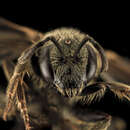zh-TW
在導航的名稱


This species is part of the subgenus Sphecodogastra, treated as a genus in the review of McGinley (2003). Forages for pollen from the Onagraceae (evening primrose family). Because these flowers open early and late in the day, bee flight patterns are matalinal and crepuscular (at dawn and dusk) (McGinley 2003). Females plug the nest entrance when they leave to forage. This, combined with the restricted foraging period, may reduce brood parasitism (McGinley 2003). Like other bees of the Sphecodogastra group of Lasioglossum, these bees are generally solitary, but with some aspects of social behavior. Females return to their natal nest to overwinter, often with other females. However only one overwintered female typically uses the nest for brood rearing and the others leave to establish their own nests (McGinley 2003). These bees excavate their nests on brush covered slopes or open woodlands (McGinley 2003). Species distribution: Lasioglossum aberrans is distributed across the Great Basin and Inter-mountain West of the USA, as well as North Dakota, USA, and southern Alberta, Manitoba, and Saskatchewan, Canada (McGinley 2003). Females fly between May and October, with the peak in June. Males fly between June and September, with the peak in July (McGinley 2003).